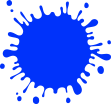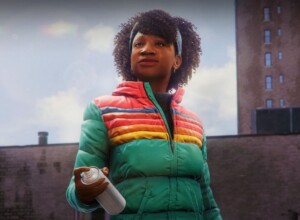The first casualty of turf war is innocence.
I remember my first reaction to Splatoon at E3 2014.
“What is this crap!?”
At first the orange goo, the Codename Kids Next Door-esque long-limbed character designs and my fundamental failure to understand that Splatoon is a portmanteau of ‘splat’ and ‘platoon’ – I was fixated on ‘toon’ – led me to believe it was some kind of Nickelodeon and Nintendo joint venture. My E3 hype levels began to wane, but directors Yusuke Amano, Tsubasa Sakaguchi and producer Hisashi Nogami continued to wax lyrical about their creation, and I had something of an epiphany.
“It all makes sense!”
This wasn’t some kind of kiddie shooter that arbitrarily substituted bullets for paint; this was something brand new. You shoot ink to cover as much turf as possible – which in itself is brilliant because it’s non-violent and visually communicative, yet terrifically anarchic – whilst also harbouring the ability to transform into a squid and swim in whatever ink you’ve unleashed upon the map, for increased mobility and platforming opportunities. The best part though, the part that glued all of this together into a near-perfect gameplay system, was that when swimming in your own ink, you refill your ink supply.
“Woah.”
That is all I could say.
Now that Splatoon has been out for a couple of months, it’s funny to look back at my initial reaction and simply laugh. I love Splatoon. I couldn’t stop talking about it after E3 and all the way up to its release, and I’m still in awe at the mechanics on display.
A lot of people I’ve spoken to recently seem to not comprehend the brilliance of Splatoon – which I find understandable, as it took me a while to get it – but it’s a real shame. Personally I feel it’s something special and deserving of some reverence, so that’s why I wish to look at certain aspects and hopefully demystify the enigma that is Splatoon.
The supreme art of turf war is to subdue the enemy without fighting
Splatoon is an odd game; it has a strong, innate sense of style that brings back distant memories of De Blob by way of Masayoshi Kikuchi. Splatoon is a shooter, but it isn’t about destruction – your weapon is well versed in more than just the colour red – it’s about creation, breathing artistic life into a drab and mundane urban setting, almost reminiscent of an anarchic Okami. Splatoon is a lot of things.
As mentioned before, it can be played non-violently, which is one of its biggest accomplishments. I’m all for violence, don’t get me wrong, but having the option to not be is just so much more vibrant and makes the game feel diverse. You don’t have to engage in frivolous skirmishes to prove your virtual worth (if you don’t want to); you can just prance about like a carefree squid-kid throwing paint wherever you see fit. Even losing is to a certain degree satisfying, as you are clearly being able to see on the map what you achieved, which gives you clear feedback and knowledge of your own actions.
In the midst of chaos, there is also opportunity
Splatoon appears to encapsulate Masahiro Sakurai’s ‘improvisation over memorisation’ Smash philosophy in how organic the gameplay feels. Since your toolset is so versatile, you don’t have to play in a systematic way. Shooting ink can lead to covering turf, or attacking enemies, or creating a safe area for you to dwell in; some people even use it for stealth by creating a small spot to hide in and wait for any unsuspecting victims.
You can go and engage in confrontation, but if you choose not to, you absolutely don’t have to; it never feels binary in that you have to choose either one or the other. In some matches I run straight to the other teams base and get killed instantly. After returning to my base and seeing some ripe patches of un-inked turf, I ink out all the gaps and then return to being a crustaceous, pre-teen Rambo.
Every match feels different with a multitude of opportunity in every direction. I was watching a friend play and saw him paint an area I’d never even considered before, which secretly excited me as this was after a I’d played the game for 20 or so hours no less.
Take advantage of the enemy’s unpreparedness; travel by unexpected routes and strike him where he has taken no precautions
Splatoon places a lot of importance in its stages as each one presents you with new prospects, as it’s not just a new area, it’s a new type of paper for you to paint on. Just as the artist has to get to grips with how their pen/pencil/brush fares on certain materials, so too does the Splatoon player need to test out their weapon of choice on a new stage. A roller maybe good on a level with narrow walkways, but can be terrible on a level that requires plenty of vertical navigation.
Learning each stage is a key element of Splatoon since knowing even the smallest, hidden patch of ground and how both teams react to said ground, may help you score that all important 1% that could change the tide of battle. Much can change in that last sliver of time before the final whistle blows and the three-minute limit on each match is exactly the right amount of time to satisfy you with enough gameplay, whilst also itching at that one-more-time part of your brain, usually reserved for the most addictive of substances.

In all fighting, the direct method may be used for joining battle, but indirect methods will be needed in order to secure victory
I tend to dub Splatoon’s peculiar control scheme as ‘tri-analogue’, in that the left stick is used for character movement, the right stick is used for horizontal camera movement and the gyro is used for vertical camera movements. It took me all of ten minutes to grasp this control scheme, but a lot of people refuse to give it a go, instead opting to use the lesser dual analogue controls—which I like to describe as painting with rubber gloves on. Think of it like the graffiti sections from Infamous: First Light, except not frustrating and terrible, and you’re not far away.
The gyro controls in Splatoon recall a childhood memory where you first pick up a hosepipe or watering can and discover gravity’s marvellous effects on liquid. You move your hands up and down and experiment, watching this almost alien, arched stream of water mutate in front of your very eyes. The gyro allows for this type of feeling to transpire when shooting ink, which is a very human feeling; something two analogues alone could never hope to achieve.
 There are not more than five primary colours, yet in combination they produce more hues than can ever been seen
There are not more than five primary colours, yet in combination they produce more hues than can ever been seen
Splatoon is an artful game that is built to communicate with you in meaningful ways (i.e. through gameplay and not unnecessary voice chat). Your main gameplay mechanic – shooting ink – is more visual than the mere bullet could ever hope to be. The whole colour aspect is pure visual communication, as anyone is able to understand that you are one colour and your enemies are another. Seeing the opposing team’s ink in an area means that either there’s an enemy there, or an enemy was there. It’s that simple.
Splatoon is, as I said before, something incredibly special. The style of the game is just so un-Nintendo – it has many echoes of a Dreamcastian era – but at the same time, perfectly Nintendo in its genius gameplay and its universal reach. I implore you to hastily take a nosedive into this giant, offbeat swimming pool of fun and multicolours that is Splatoon, so says Spla Tzu.







